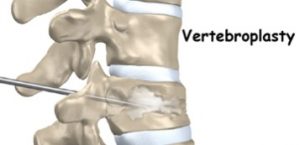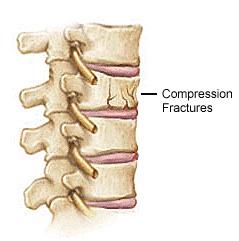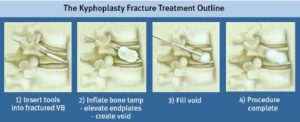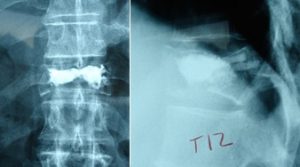
vertebroplasty kyphoplasty
What is a Vertebroplasty or Kyphoplasty?
The premise behind a vertebroplasty or kyphoplasty is essentially the same general concept. When an individual has a spinal fracture from osteoporosis or a tumor, it can be extremely painful. Performing a vertebroplasty or kyphoplasty involves injecting a special type of bone cement into the fracture to stabilize it and reduce pain. The procedure is short, low risk, and done as an outpatient by pain management doctors in Arizona.
involves injecting a special type of bone cement into the fracture to stabilize it and reduce pain. The procedure is short, low risk, and done as an outpatient by pain management doctors in Arizona.
Who is a candidate for a Vertebroplasty or Kyphoplasty at an Arizona pain center?
For those individuals who have a spinal compression fracture, commonly known as a vertebral compression fracture, the procedure may benefit tremendously. The most common age group for this procedure is over 70 as that is when osteoporosis typically becomes an issue. Patients with a vertebral compression fracture due to a cancer such as multiple myeloma also may benefit from a vertebroplasty or kyphoplasty.
If a person has a vertebral compression fracture that is old, and the body is no longer attempting to heal it, then the vertebroplasty procedure will probably be of no benefit. An MRI can help tell whether or not the body is still trying to heal the fracture. If the fracture is less than a few months old, remains painful, and the body is trying to heal it, that person is usually a great candidate for either a vertebroplasty or a kyphoplasty.
What are the Symptoms of a Vertebral Compression Fracture?

MRI showing vertebral compression fracture that is acute and “lights up” on the study.
People who sustain compression fractures often have no clue as they may be clinically silent and painless. Or they may cause significant back pain and aching in the area surrounding the broken bone. This may be anywhere in the low back or mid-back. If the fracture is in the thoracic region, pain may radiate around the flank into the front of the abdominal or chest area. This is due to irritation from the fracture on the intercostal nerves.
A person may also have significant spasms in the muscles around the back due to the body’s attempt to stabilize the fracture.
What is the difference between a vertebroplasty and a kyphoplasty?
The essential purpose of each procedure is the same, to reduce pain emanating from a vertebral compression fracture by inserting bone cement for stabilization. The difference in the procedures however, comes in exactly how the procedure is performed.
A vertebroplasty procedure involves a minimally invasive insertion of a catheter into the broken vertebrae. This is performed by pain management doctors, interventional radiologists, and orthopedic doctors who have received special certification.
The catheter is inserted using fluoroscopy, which is a real-time form of x-ray. Once the catheters are inside the fracture, the bone cement is injected and allowed to harden inside the vertebrae for stabilization of the fracture. The bone cement does not promote healing of the fracture, rather, it stabilizes the break and provides for pain relief along with increased function compared to conservative treatment.
A kyphoplasty procedure also is performed in a minimally invasive fashion as an outpatient procedure. Under fluoroscopy, catheters are inserted into the broken bone, however, in the kyphoplasty procedure balloons are inflated in order to develop a bony void. These balloons are filled with saline, creating a void inside the fracture and pushing the bony fragments away.
Into this bony void is a space where the pain doctor then inserts under low-pressure the same type of bone cement as in a vertebroplasty. The balloons are removed prior to cement insertion.
The essential difference between the two procedures is that the vertebroplasty does not create the bony void prior to cement insertion so requires putting the cement in under a higher pressure. It is unclear in research studies whether one is superior to another with the outcome. What one can see in the picture below is a kyphoplasty. For a vertebroplasty step 2 is skipped.
abdominal or chest area. This is due to irritation from the fracture on the intercostal nerves.
A person may also have significant spasms in the muscles around the back due to the body’s attempt to stabilize the fracture.
What is the difference between a vertebroplasty and a kyphoplasty?
The essential purpose of each procedure is the same, to reduce pain emanating from a vertebral compression fracture by inserting bone cement for stabilization. The difference in the procedures however, comes in exactly how the procedure is performed.
A vertebroplasty procedure involves a minimally invasive insertion of a catheter into the broken vertebrae. This is performed by pain management doctors, interventional radiologists, and orthopedic doctors who have received special certification.
The catheter is inserted using fluoroscopy, which is a real-time form of x-ray. Once the catheters are inside the fracture, the bone cement is injected and allowed to harden inside the vertebrae for stabilization of the fracture. The bone cement does not promote healing of the fracture, rather, it stabilizes the break and provides for pain relief along with increased function compared to conservative treatment.
A kyphoplasty procedure also is performed in a minimally invasive fashion as an outpatient procedure. Under fluoroscopy, catheters are inserted into the broken bone, however, in the kyphoplasty procedure balloons are inflated in order to develop a bony void. These balloons are filled with saline, creating a void inside the fracture and pushing the bony fragments away.
Into this bony void is a space where the pain doctor then inserts under low-pressure the same type of bone cement as in a vertebroplasty. The balloons are removed prior to cement insertion.
The essential difference between the two procedures is that the vertebroplasty does not create the bony void prior to cement insertion so requires putting the cement in under a higher pressure. It is unclear in research studies whether one is superior to another with the outcome. What one can see in the picture below is a kyphoplasty. For a vertebroplasty step 2 is skipped.

How well do these procedures work?
These procedures work exceptionally well in patients who have symptoms remaining from the fracture. If the person has back pain in a different place than where the fracture is, then the vertebroplasty may not help. A back brace may be tried first, and if it fails to provide adequate pain relief a kyphoplasty or vertebroplasty may be tried next. The typical window for effective treatment is within two to three months after the fracture occurs.
Usually the procedure provides instant pain relief. There may be some residual muscle spasms from the lower back trying to protect the area through the fracture, which typically subsides over the ensuing few days due to the fracture stabilization.
subsides over the ensuing few days due to the fracture stabilization.
There have been multiple studies published showing the excellent results of the vertebroplasty procedure for both immediate and longer term results. (Lancet 2009 and 2010 and Osteoporosis Int 2010). Typically over 90% of patients see dramatic pain relief immediately with significantly increased function including walking and performing activities of daily living.
There have been two recently published articles in the New England Journal of Medicine (2009) disputing the benefits of vertebroplasty, which were large studies but interestingly some of the few studies showing no benefit of the procedure. These studies have been criticized for including patients whose fractures were older than a few months
Call (602) 507 – 6550 to schedule your Appointment TODAY!![]()
How long does a verterbroplasty or kyphoplasty procedure take to perform?
If the person has a one level fracture the procedure usually takes about 30 to 45 minutes. At times it may take longer if the person has significant scoliosis making it difficult to properly and safely enter the fracture.
In addition, it’s very common for people with significant osteoporosis to have multiple spinal compression fractures that need to be treated at the same time. Therefore, it would not be unusual for the procedure to take over an hour.
Afterwards, patients are able to go home the same day. The cement that is injected hardens within 20 minutes or so, so it is stable prior to the individual going home.
The successful results from a vertebroplasty or kyphoplasty procedure are over 90%. Patients achieve substantial pain relief and increased function. There is definitely a risk of having compression fractures at the levels above or below the ones that have been treated, and it has been debated whether or not there’s an increase risk in those who have a vertebroplasty versus those who receive conservative treatment.
What are the risks of the vertebroplasty or kyphoplasty procedure?
These procedures are low risk but they are not risk free. There is a risk of infection that is small but anytime you put a needle through the skin that can occur. There’s a risk of bleeding during the procedure especially if someone is on blood thinner medications. Those medications should be stopped 5 to 7 days prior to the procedure, ask your doctor about the specific timeframe.
Neurologic injury can occur rarely. When the cement is injected, it’s in liquid form and sometimes will leak out from its intended location. The vast majority of the time this is inconsequential, but rarely the cement can envelop a nerve root or the area around the spinal cord itself.
As the cement converts from liquid into solid, it gets very warm and can damage structures around it. This is why doctors use fluoroscopy to ensure satisfactory placement of the catheters prior to insertion of the cement. In addition, the bone cement has contrast dye in it to see if it is going to an unintended location. It can be difficult to delineate whether or not this is occurring however.
Will the procedure need to be repeated?
The vertebroplasty or kyphoplasty procedure is not one that a person has repeated at the same level. Once the cement has been injected, it does not disintegrate or go away. It hardens and sticks around forever.
This does not mean however, that a compression fracture will not occur at the level above or below the one that was treated. This happens very commonly and may be treated with another procedure at these new levels with the expectation that the symptom relief will be just as good.
The pain management doctors at Arizona Pain Specialists are Double Board Certified and have performed hundreds of vertebroplasty and kyphoplasty procedures for patients with  vertebral compression fractures. They have Arizona pain clinics all around the Valley, and take a considerable amount of insurances.
vertebral compression fractures. They have Arizona pain clinics all around the Valley, and take a considerable amount of insurances.
Call (602) 507 – 6550 to schedule your Appointment TODAY!
![]()
